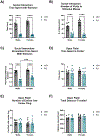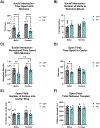Maternal immune activation with toll-like receptor 7 agonist during mid-gestation alters juvenile and adult developmental milestones and behavior
- PMID: 38822791
- PMCID: PMC11296912
- DOI: 10.1111/jne.13417
Maternal immune activation with toll-like receptor 7 agonist during mid-gestation alters juvenile and adult developmental milestones and behavior
Abstract
Infections during pregnancy are associated with increased risk for adult neuropsychiatric disease, such as major depressive disorder, schizophrenia, and autism spectrum disorder. In mouse models of maternal immune activation (MIA), different toll-like receptors (TLRs) are stimulated to initiate inflammatory responses in mother and fetus. The goal of this study was to determine sex-dependent aspects of MIA using a TLR7/8 agonist, Resiquimod (RQ), on neurodevelopment. RQ was administered to timed-pregnant mice on embryonic day (E) 12.5. At E15, maternal/fetal plasma cytokines were measured by enzyme-linked immunosorbent assay (ELISA). Maternal cytokines interleukin (IL)-6 and IL-10 were higher while tumor necrosis factor (TNF)-α and IL-17 were lower in pregnant dams exposed to RQ. Fetal cytokines (E15) were altered at the same timepoint with fetal plasma IL-6 and IL-17 greater after RQ compared to vehicle, while IL-10 and TNF-α were higher in male fetuses but not female. Other timed-pregnant dams were allowed to give birth. MIA with RQ did not alter the female to male ratio of offspring born per litter. Body weights were reduced significantly in both sexes at birth, and over the next 5 weeks. Offspring from RQ-injected mothers opened their eyes 5 days later than controls. Similarly, female offspring from RQ-injected mothers exhibited pubertal delay based on vaginal opening 2-3 days later than control females. On the behavioral side, juvenile and adult male and female MIA offspring exhibited less social-like behavior in a social interaction test. Anhedonia-like behavior was greater in MIA adult female mice. This study provides support for sex-dependent influences of fetal antecedents for altered brain development and behavioral outputs that could be indicative of increased susceptibility for adult disorders through immune mechanisms. Future studies are needed to determine neural cellular and molecular mechanisms for such programming effects.
Keywords: behavior; depression; immune; pregnancy; stress.
© 2024 The Author(s). Journal of Neuroendocrinology published by John Wiley & Sons Ltd on behalf of British Society for Neuroendocrinology.
Conflict of interest statement
Conflicts of interest
The authors of the manuscript have no conflicts of interest to declare.
Figures







References
Publication types
MeSH terms
Substances
Grants and funding
LinkOut - more resources
Full Text Sources

